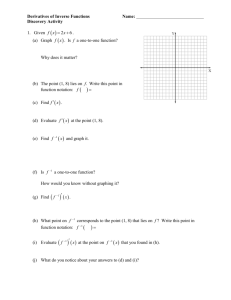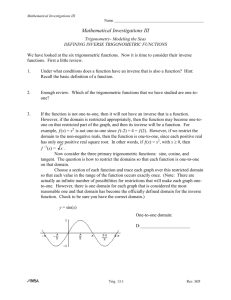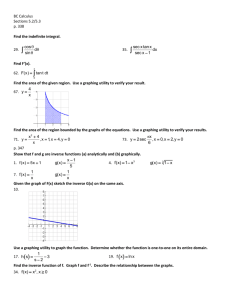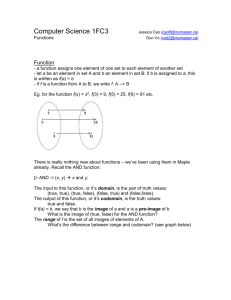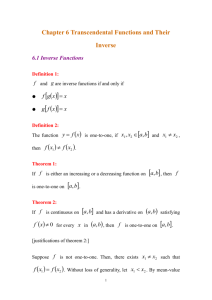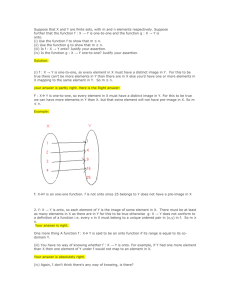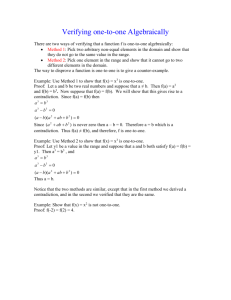Solutions to Homework 6 1. A function f(x) is called one-to
advertisement
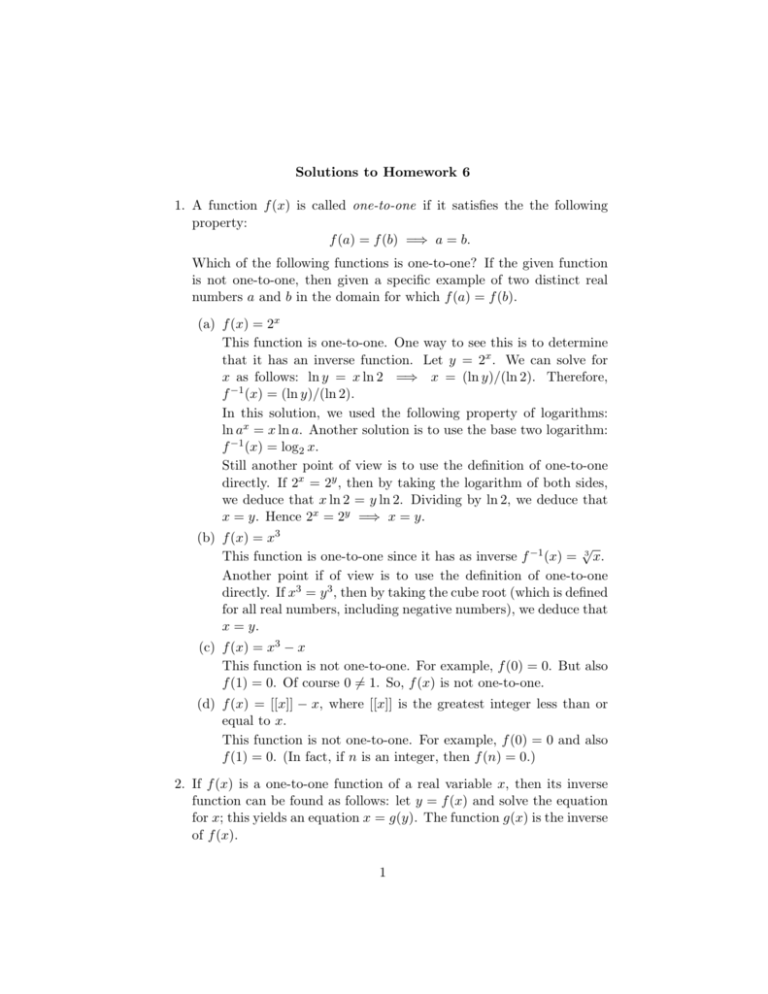
Solutions to Homework 6 1. A function f (x) is called one-to-one if it satisfies the the following property: f (a) = f (b) =⇒ a = b. Which of the following functions is one-to-one? If the given function is not one-to-one, then given a specific example of two distinct real numbers a and b in the domain for which f (a) = f (b). (a) f (x) = 2x This function is one-to-one. One way to see this is to determine that it has an inverse function. Let y = 2x . We can solve for x as follows: ln y = x ln 2 =⇒ x = (ln y)/(ln 2). Therefore, f −1 (x) = (ln y)/(ln 2). In this solution, we used the following property of logarithms: ln ax = x ln a. Another solution is to use the base two logarithm: f −1 (x) = log2 x. Still another point of view is to use the definition of one-to-one directly. If 2x = 2y , then by taking the logarithm of both sides, we deduce that x ln 2 = y ln 2. Dividing by ln 2, we deduce that x = y. Hence 2x = 2y =⇒ x = y. (b) f (x) = x3 √ This function is one-to-one since it has as inverse f −1 (x) = 3 x. Another point if of view is to use the definition of one-to-one directly. If x3 = y 3 , then by taking the cube root (which is defined for all real numbers, including negative numbers), we deduce that x = y. (c) f (x) = x3 − x This function is not one-to-one. For example, f (0) = 0. But also f (1) = 0. Of course 0 6= 1. So, f (x) is not one-to-one. (d) f (x) = [[x]] − x, where [[x]] is the greatest integer less than or equal to x. This function is not one-to-one. For example, f (0) = 0 and also f (1) = 0. (In fact, if n is an integer, then f (n) = 0.) 2. If f (x) is a one-to-one function of a real variable x, then its inverse function can be found as follows: let y = f (x) and solve the equation for x; this yields an equation x = g(y). The function g(x) is the inverse of f (x). 1 Here is an example. If f (x) = 2x + 7, then f (x) is one-to-one. To find the inverse, we solve the equation y = 2x + 7 for the variable x. We obtain x = (y − 7)/2. Therefore the function g(x) = (x − 7)/2 is the inverse of f (x). Find the inverse of each of the following functions. (a) f (x) = x3 − 8 The inverse function is found by solving the equation y = x3 − 8 √ 3 for x. We determine that x = y + 8. Therefore, f −1 (x) = √ 3 x + 8. (b) f (x) = e2x Solve y = e2x for x by first taking the logarithm of both sides. Since ln x is the inverse of ex , we can use the fact that ln ex = x. Therefore, if y = e2x , then ln y = 2x. Hence x = (ln y)/2. And so f −1 (x) = (ln x)/2. (c) f (x) = 3 sin x, where −π/2 ≤ x ≤ π/2 To solve y = 3 sin x we use the arcsine function, which I will denote by sin−1 x. You must first divide both sides of the equation by 3. The reason why is that the arcsine function has the property that sin−1 (sin x) = x; this property does not suggest in any way that the term sin x can be preceded by a number (or anything else). So, dividing by 3, we have that (y/3) = sin x; now taking the arcsine of both sides, we have that sin−1 (y/3) = x. Therefore, f −1 (x) = sin−1 (x/3). You may ask what is the domain of f −1 (x). The answer is that the domain of f −1 (x) is equal to the range of f (x). Since the range of f (x) = 3 sin x is [−3, 3], the domain of f −1 (x) = sin−1 (x/3) is [−3, 3]. (d) f (x) = tan−1 (x/2) To solve y = tan−1 (x/2), we apply the tangent function to both sides of the equation to obtain tan y = x/2. Therefore x = 2 tan y. So, f −1 (x) = 2 tan x, however we must restrict the domain to (−π/2, π/2). The domain and range of these functions can be determined as in the previous problem. Since the range of f −1 (x) = 2 tan x is equal to (−∞, ∞), the domain of f (x) is equal to (−∞, ∞). And since the range of f (x) = tan−1 x/2 is (−π/2, π/2), the domain of f −1 (x) is (−π/2, π/2). This is a subtle point. The issue is that the tangent function is defined for all real numbers except those 2 numbers of the form π2 + nπ, where n is an integer. As given, the tangent function is not one-to-one. However, if we restrict the domain to (−π/2, π/2), the function becomes one-to-one. (This is analogous to choosing either the positive square root or the negative square root when solving y = x2 for x; a choice must be made if you are to arrive at a function.) These matters are discussed in more detail in section 1.5. 3. If f (x) and g(x) are inverses of one another, then their graphs are mirror reflections of one another across the line y = x. Illustrate this fact by sketching the graphs y = f (x) and the graph y = f −1 (x) for each of the functions in problem 2 above. List the exact coordinates of at least three points on each graph. You should use a graphing utility such as fooplot.com or a calculator to assist with your sketches. In the graphs below, there is a sketch of y = f (x), y = f −1 (x), and the line y = x (to illustrate the mirror reflection). (a) f (x) = x3 − 8, f −1 (x) = √ 3 x+8 3 (b) f (x) = e2x , f −1 = (ln x)/2. (c) f (x) = 3 sin x, f −1 = sin−1 (x/3). 4 (d) f (x) = tan−1 (x/2), f −1 = 2 tan x. 4. The derivative of a function and its inverse are reciprocals of one another provided you evaluate the derivative at values which correspond to each other via the function. Illustrate this by computing f 0 (2) and (f −1 )0 (32) for the function f (x) = x5 . √ First, let’s compute f −1 (x). Solving y = x5 for x, we obtain x = 5 y. √ Therefore, f −1 (x) = 5 x = x1/5 . Now we compute the derivatives: f 0 (x) = 5x4 and (f −1 )0 (x) = (1/5)x−4/5 . Evaluating, we find that f 0 (2) = 5(2)4 = 80 and that (f −1 )0 (32) = (1/5)(32)−4/5 = (1/5)(2)−4 = (1/5)(1/16) = 1/80. 5
